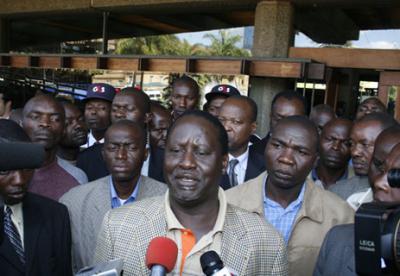As general elections approach, pragmatic allegiances along ethnic lines and tensions between communities could increase.
By Nikita Bernardi

Nairobi, Kenya:
The conflict in the Tana delta region of Kenya between the Orma and Pokomo communities claimed more than 100 lives in just two weeks earlier this month. A curfew, the deployment of the General Service Unit and calls for military intervention seem to have quelled the fighting, although the government’s sluggishness in responding has been criticised. And even though the violence has stopped and arrests have been made, hundreds more villagers have lost their homes, livestock and farming land and they are too afraid to return to the area, choosing instead to remain in makeshift camps along the Kenyan coast.
Although claims of two mass graves apparently discovered near Ozi village have been dismissed, the mystery around them grows, and many are starting to blame the clashes in the area on more than just land and water disputes. The attacks on villagers have been described as organised and planned, leading many to believe that underlying political forces contributed to the violence.
What motivated the violence?
As has been pointed out by one researcher, if this was really a dispute over access to land and water – a “herder-farmer problem” – the Orma and Pokomo should have been able to formulate some kind of creative solution as other tribes in the Laikipia region have done. Even more worrying is the revelation that the government was reportedly warned about the possibility of conflict as early as May. At that time, residents complained to the government about boundaries changes and gave a three-month notice period, after which, they said, they would solve the issue themselves by any means necessary.
Furthermore, the politicking between acting Internal Security minister Yusuf Haji and local Galole district MP Dhadho Godhana, each of whom blames the other and refuses to partake in peace talks because of personal differences, enhances the political undertones of the violence.
Indeed, the Kenyan media seems sure that these are predominantly political battles, describing the violence as being due to “jostling for elective positions in next year’s General Election”.
‘Politics’ without politics
In Kenya, votes are rarely cast due to a political or ideological belief. The fight is not so much between Left and Right but between individual candidates, both at the local and national level. This is no more evident than in the curious fact that every time there has been a general election since the Kenya African National Union (KANU) lost for the first time in 2002, the individual politicians competing for the top positions have often been the same even though the political party backing them frequently changes.
People do not vote because of ideas but according to what will be most beneficial for them – this is usually the party from their region or a leader from their ethnic group. The majority of parties in Kenya are more of a support system for a specific candidate and are almost always ethnically-based, using this specific identity to mobilise support. Kenyan parties are merely a formality for elections and remain inactive when there is not an election year, as reflected by the overwhelming lack of party websites. Instead, we see the personal websites of Uhuru Kenyatta, Kalonzo Musyoka, Raila Odinga and William Ruto, each contending in next year’s election.
Kenya’s political elite can be seen then as an entity that fights amongst itself for the top spots using means other than political ideology to garner votes when necessary.
Ethnic allegiances
The centrality of ethnicity to political mobilisation in Kenya has been well-documented by academics and journalists inside and outside Kenya. Ethnicity is thought to be the easiest identity to exploit during elections and it is notable, for example, that President Mwai Kibaki, a Kikuyu, won around 97% of the vote from his home region of Central Province in the 2007 elections.
The widely held assumption that Kenyans will vote along ethnic lines is partly due to the connection between the elite and their communities. It is understood that if a certain community votes someone into a position of power, the people of that community will benefit. There is an attitude that the state is a prize which will be shared out amongst a community once it has been acquired. This is in part a legacy of Kenya’s political system under colonialism in which colonialists would often explicitly associate political figures with their ethnic community and take them as representative of it.
Owing to the fact that not all ethnic groups are of the same size, however, politicians vying for the presidency often resort to forming alliances and coalitions with leaders from other ethnic groups. This is what academic Sebastian Elischer has labelled “coalitions of convenience”. A clear example of this is the National Alliance Rainbow Coalition (NARC) which defeated KANU in 2002. Kibaki and Raila were both a part of NARC but even by 2005 they had split into separate groups – the Party of Natonal Unity (PNU) and the Orange Democratic Movement (ODM) – and eventually went head to head in the 2007 general election.
Making deals
However to blame all Kenya’s political problems on ethnicity would be irresponsible and reductionist. More often than not, after leaders of the opposition have lost an electoral battle, they simply shift allegiance to the party in power. Or, as is being shown by the rising popularity of Uhuru’s newly-formed The National Alliance (TNA) party, even before elections, politicians or those with vested interests will “scramble” to show their support if it seems a certain individual’s power is increasing.
More recently at a political rally in Ukambani, an area with a predominantly Kamba population and therefore a stronghold of Kalonzo Musyoka, Prime Minister Raila Odinga, a Luo, suggested that himself and Musyoka should join forces. Odinga advised Kamba people to “shun” ethnic politics and vote for him, but to be safe invited Kalonzo to join him. As the election – slated for March 2013 – nears, these kinds of proposals will continue and it will be interesting to see who will be the first to abandon their personal bid for the top spot in exchange for a lesser position of power but one that that will at least guarantee a term in government.
All this highlights the unfortunate situation in which Kenya’s political elite use apparent ethnic differences when it is convenient for them. It is this pitting against each other of ethnic groups by the elite which tends to have short-term gains for the politicians and devastatingly long-term losses for unlucky communities that miss out.
The Orma and Pokomo are two relatively small tribes who, apart from a few isolated incidents, have managed to coexist in considerable peace. Yet as the election nears, their apparent differences seem to become a problem – this is certainly not mere coincidence. If reports of incitement to violence by local MPs in the Tana delta are true, one cannot help but be concerned about the even greater power struggles that will occur next year. The problem is not that Kenyan people “like to fight”; as can be seen from social networking sites and talking to Kenyans, those against the violence always outnumber those for it. The problem is a culture of political contestation based on what is purported to be a zero-sum competition along essentialised ethnic divides, something promoted and sustained by a political elite who stand to gain the most and lose the least. For the long-term good of Kenya, politicians need to be more responsible – inciting violence should never be an option.

